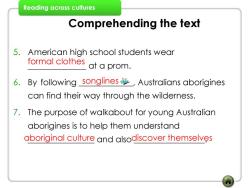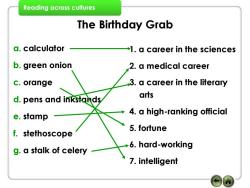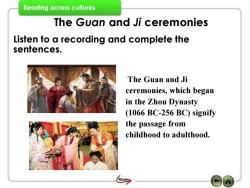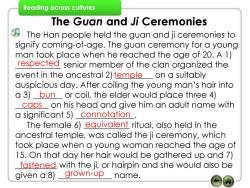《大学英语读写》课程教学资源(B)Ⅲ_大学英语读写(B)Ⅲ_Unit one_Reading across cultures

Reading across culturesRites of passageComprehendingthetextCultural awarenessTalking pointInformationneeded
Talking point Comprehending the text Cultural awareness Reading across cultures Rites of passage Information needed

Reading across culturesComprehending the textFor guestions 1-4 checkthe true statements; forquestions 5-7 complete the sentences.Life was oneproblem afteranotherF 1. Elbert Hubbard thought that life was an obstacle raceT2. There are 7 stages to a person's existence.F3. A rite of passage is a formal recognition of changefrom childhood to adulthoodone stage of lifeto anotherT 4. According to Jewish Children, the Bar Mitzvah meansthey become responsible for their own actions.More
1. Elbert Hubbard thought that life was an obstacle race. 2. There are 7 stages to a person’s existence. 3. A rite of passage is a formal recognition of change from childhood to adulthood. 4. According to Jewish Children, the Bar Mitzvah means they become responsible for their own actions. Reading across cultures More For questions 1-4 check the true statements; for questions 5-7 complete the sentences. T F F one stage of life to another Comprehending the text T Life was one problem after another

Reading across culturesComprehending the text5. American high school students wearformal clothesat a prom.6. By following _songlines , Australians aboriginescanfindtheir way through the wilderness7. The purpose of walkabout for young Australianaborigines is to help them understandaboriginal culture and alsodiscover themselves
5. American high school students wear _ at a prom. 6. By following _, Australians aborigines can find their way through the wilderness. 7. The purpose of walkabout for young Australian aborigines is to help them understand _ and also _. Reading across cultures formal clothes Comprehending the text aboriginal culture discover themselves songlines Songlines are an ancient spiritual concept among aboriginal communities in a 40,000-year-old culture. Songlines, or dreaming tracks, footprints of the ancestors, are invisible paths which criss-cross Australia, connecting sources of water, food and landmarks. For aborigines, the world was created and named when the ancestors sang out the names of everything, giving life in singing. The world continues because it is maintained by people who sing these ancient songs in the right way when they are on walkabout. The songlines are spiritual and cultural maps. By singing them, aborigines can keep the land alive and find their way across long distances, deserts or mountains, or locate water and food. click

Reading across culturesCultural awareness* Identifying pictures米The birthday grab* The Guan and Jiceremonies
Reading across cultures Cultural awareness Identifying pictures The Guan and Ji ceremonies The birthday grab

Reading across culturesIdentifying picturesLook at the pictures and identify what ceremoniesthey refer to in Chinese.Chinese ancients held to the beliefthat a true man has a dignifiedbearing, speaks courteously andbehaves in accordance withconventional rituals. Theyconsidered that observance of theserituals indeed constituted thefoundation of personal growth andof a stable and harmonious societMore
Reading across cultures Identifying pictures Look at the pictures and identify what ceremonies they refer to in Chinese. Chinese ancients held to the belief that a true man has a dignified bearing, speaks courteously and behaves in accordance with conventional rituals. They considered that observance of these rituals indeed constituted the foundation of personal growth and of a stable and harmonious society. More

Reading across culturesIdentifying picturesTheGuanLiThebirthdaygrabDThegraduationceremonyTheJi Li
Reading across cultures Identifying pictures The Guan Li The Ji Li The birthday grab The graduation ceremony

Reading across culturesThe Birthday GrabMatch the items with their symbolic meaningsOn the first birthday, a壁福光锅新辣锅2E8实WAFeset of items areplacedbefore thebirthdaychildsothatthechild maypickwhateverheorshefancies.Whateveritemthechildpicksand successfullygivesto his or her parents maybe an indication of thechild's future career.More
Reading across cultures The Birthday Grab Match the items with their symbolic meanings. On the first birthday, a set of items are placed before the birthday child so that the child may pick whatever he or she fancies. Whatever item the child picks and successfully gives to his or her parents may be an indication of the child’s future career. More

Reading across culturesThe Birthday Graba. calculator1.acareerinthesciencesb.green onion2. a medical career3. a career in the literaryC. orangeartsd. pens and inkstands4. a high-ranking officiale. stamp5.fortunef. stethoscope6.hard-workingg. a stalk of celery7. intelligent
a. calculator b. green onion c. orange d. pens and inkstands e. stamp f. stethoscope g. a stalk of celery Reading across cultures 1. a career in the sciences 2. a medical career 3. a career in the literary arts 4. a high-ranking official 5. fortune 6. hard-working 7. intelligent The Birthday Grab

ReadingacrossculturesThe Guan and Ji ceremoniesListen to a recording and complete thesentences.The Guan and Jiceremonies,which beganin the Zhou Dynasty(1066 BC-256 BC) signifythe passagefromchildhood to adulthoodMore
Reading across cultures The Guan and Ji ceremonies The Guan and Ji ceremonies, which began in the Zhou Dynasty (1066 BC-256 BC) signify the passage from childhood to adulthood. More Listen to a recording and complete the sentences

Readingacross culturesThe Guan and Ji CeremoniesSThe Han people held the guan and ji ceremonies tosignify coming-of-age. The guan ceremony for a youngman took place when he reached the age of 20. A 1)respected senior member of the clan organized theevent in the ancestral 2) temple _ on a suitablyauspicious day. After coiling the young man's hair intoa 3) bun _ or coil, the elder would place three 4)caps on his head and give him an adult name witha significant 5) connotationThe female 6) equivalent ritual, also held in theancestral temple, was called the ji ceremony, whichtook place when a young woman reached the age of15. On that day her hair would be gathered up and 7)fastened with the ji, or hairpin and she would also begiven a 8)grown-up name
The Han people held the guan and ji ceremonies to signify coming-of-age. The guan ceremony for a young man took place when he reached the age of 20. A 1) _ senior member of the clan organized the event in the ancestral 2) _ on a suitably auspicious day. After coiling the young man’s hair into a 3) _ or coil, the elder would place three 4) _ on his head and give him an adult name with a significant 5) _. The female 6) _ ritual, also held in the ancestral temple, was called the ji ceremony, which took place when a young woman reached the age of 15. On that day her hair would be gathered up and 7) _ with the ji, or hairpin and she would also be given a 8) _ name. Reading across cultures The Guan and Ji Ceremonies respected temple bun caps connotation equivalent fastened grown-up
按次数下载不扣除下载券;
注册用户24小时内重复下载只扣除一次;
顺序:VIP每日次数-->可用次数-->下载券;
- 《大学英语读写》课程教学资源(B)Ⅰ_大学英语读写(B)Ⅰ_大学英语学习导论_大学英语学习导论.ppt
- 《大学英语读写》课程教学资源(B)Ⅰ_大学英语读写(B)Ⅰ_素材_A Good Heart to Lean on.doc
- 《大学英语读写》课程教学资源(B)Ⅰ_大学英语读写(B)Ⅰ_2020新生大学英语读写学习导论.ppt
- 《大学英语读写》课程教学资源(B)Ⅰ_大学英语读写(B)Ⅰ_Unit 1 preparation.ppt
- 《综合英语》课程教学资源Ⅲ_50550_课程资源_综合英语Ⅲ_Unit 12 The Most Dangerous Game_教学课件_Book3 Unit12 教师参考课件.ppt
- 《综合英语》课程教学资源Ⅲ_50550_课程资源_综合英语Ⅲ_Unit 12 The Most Dangerous Game_预习课件_Book3 Unit12 预习课件1.ppt
- 《综合英语》课程教学资源Ⅲ_50550_课程资源_综合英语Ⅲ_Unit 12 The Most Dangerous Game_预习课件_Book3 Unit12 预习课件2.ppt
- 《综合英语》课程教学资源Ⅲ_50550_课程资源_综合英语Ⅲ_Unit 12 The Most Dangerous Game_预习课件_Book3 Unit12 预习课件3.ppt
- 《综合英语》课程教学资源Ⅲ_50550_课程资源_综合英语Ⅲ_Unit11 Why Historians Disagree_教学课件_Book3 Unit11 教师参考课件.ppt
- 《综合英语》课程教学资源Ⅲ_50550_课程资源_综合英语Ⅲ_Unit11 Why Historians Disagree_预习课件_Book3 Unit11 预习课件1.ppt
- 《综合英语》课程教学资源Ⅲ_50550_课程资源_综合英语Ⅲ_Unit11 Why Historians Disagree_预习课件_Book3 Unit11 预习课件2.ppt
- 《综合英语》课程教学资源Ⅲ_50550_课程资源_综合英语Ⅲ_Unit11 Why Historians Disagree_预习课件_Book3 Unit11 预习课件3.ppt
- 《综合英语》课程教学资源Ⅲ_50550_课程资源_综合英语Ⅲ_Unit 8 In My Day_教学课件_Book3 Unit8 教师参考课件.ppt
- 《综合英语》课程教学资源Ⅲ_50550_课程资源_综合英语Ⅲ_Unit 8 In My Day_预习课件_Book3 Unit8 预习课件1.ppt
- 《综合英语》课程教学资源Ⅲ_50550_课程资源_综合英语Ⅲ_Unit 8 In My Day_预习课件_Book3 Unit8 预习课件2.ppt
- 《综合英语》课程教学资源Ⅲ_50550_课程资源_综合英语Ⅲ_Unit 8 In My Day_预习课件_Book3 Unit8 预习课件3.ppt
- 《综合英语》课程教学资源Ⅲ_50550_课程资源_综合英语Ⅲ_Unit 5 Silent Spring_教学课件_Unit 5 教师用课件.ppt
- 《综合英语》课程教学资源Ⅲ_50550_课程资源_综合英语Ⅲ_Unit 5 Silent Spring_拓展资料_The 2020 President-elect:Joe Biden.pdf
- 《综合英语》课程教学资源Ⅲ_50550_课程资源_综合英语Ⅲ_Unit 5 Silent Spring_预习课件_book3-unit 5 预习课件1.ppt
- 《综合英语》课程教学资源Ⅲ_50550_课程资源_综合英语Ⅲ_Unit 5 Silent Spring_预习课件_book3-unit 5 预习课件2.ppt
- 《大学英语读写》课程教学资源(B)Ⅲ_大学英语读写(B)Ⅲ_Unit one_Guided Writing.pdf
- 《大学英语读写》课程教学资源(B)Ⅲ_大学英语读写(B)Ⅲ_Unit one_language in use.ppt
- 《大学英语读写》课程教学资源(B)Ⅲ_大学英语读写(B)Ⅲ_Unit Three_Reading across cultures.pdf
- 《大学英语读写》课程教学资源(B)Ⅲ_大学英语读写(B)Ⅲ_Unit Three_Language in Use.pdf
- 《大学英语读写》课程教学资源(B)Ⅲ_大学英语读写(B)Ⅲ_Unit Three_Guided Writing.pdf
- 《大学英语读写》课程教学资源(B)Ⅲ_大学英语读写(B)Ⅲ_Unit Three_Unit 3 text.pdf
- 《大学英语读写》课程教学资源(B)Ⅲ_大学英语读写(A)Ⅲ_大学英语导读_大学英语发展概论(2016).ppt
- 《大学英语读写》课程教学资源(A)Ⅱ_四级资源_词汇_英语四六级考试考前突击必备的1000个核心单词.doc
- 《大学英语读写》课程教学资源(A)Ⅱ_四级资源_词汇_英语四级过级考试必须完全熟练的最基础短语(仅限低基础者).doc
- 《大学英语读写》课程教学资源(A)Ⅱ_四级资源_词汇_英语四级过级考试必须完全熟练的最核心短语(新东方短语表).doc
- 《大学英语读写》课程教学资源(A)Ⅱ_四级资源_词汇_英语四级阅读猜词技巧.ppt
- 《大学英语读写》课程教学资源(A)Ⅱ_四级资源_词汇_阅读猜词技巧..doc
- 《大学英语读写》课程教学资源(A)Ⅱ_四级资源_作文_大学英语四级作文讲解.ppt
- 《大学英语读写》课程教学资源(A)Ⅱ_四级资源_匹配题_阅读信息匹配.doc
- 《大学英语读写》课程教学资源(A)Ⅱ_四级资源_段落翻译_四级翻译练习材料.doc
- 《大学英语读写》课程教学资源(A)Ⅱ_四级资源_段落翻译_四级翻译辅导.ppt
- 《大学英语读写》课程教学资源(A)Ⅱ_四级资源_段落翻译_汉英翻译——-新四级.doc
- 《大学英语读写》课程教学资源(A)Ⅱ_四级资源_段落翻译_汉译英技巧..ppt
- 《大学英语读写》课程教学资源(A)Ⅱ_四级资源_段落翻译_预测段落翻译30篇.doc
- 《大学英语读写》课程教学资源(A)Ⅱ_四级资源_词汇_四六级使用率最高的580个词汇.doc
